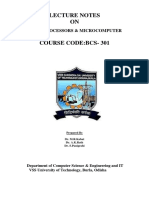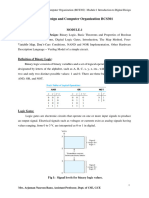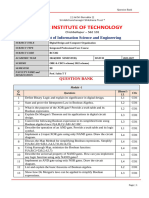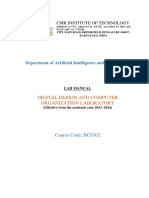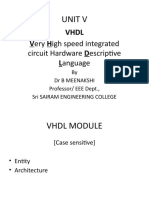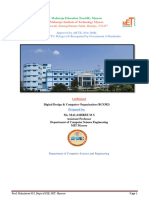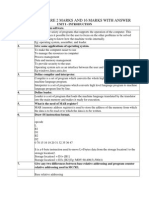Module 5
Uploaded by
VishnupriyaModule 5
Uploaded by
VishnupriyaBCS302- DDCO-VTU 2022 scheme
MODULE-5 BASIC PROCESSING UNIT
5.1 Some Fundamental Concepts
To execute an instruction, processor has to perform following 3 steps:
1) Fetch contents of memory-location pointed to by PC. Content of this location is an instruction
to be executed. The instructions are loaded into IR, Symbolically, this operation can be written as
IR[[PC]]
2) Increment PC by 4 P, [PC] +4
3) Carry out the actions specified by instruction (in the IR).
The first 2 steps are referred to as fetch phase; Step 3 is referred to as execution phase.
The operations specified by an instruction can be carried out by performing one or more
of the following actions:
1. Read the content of a given memory-location and load them into a register.
2.Read data from one or more register
3.Perform ALU operations and place the result into the register.
4.Store data from a register into a given memory location.
Figure 5.1 shows the single bus organization. ALU and all the registers are interconnected
via a single common bus. Data and address line of the external memory bus is connected to the
internal processor bus via MDR and MAR respectively(MDR-Memory Data Register and MAR-
Memory Address Register).
MDR has 2 inputs and 2 outputs. Data may be loaded
→ into MDR either from memory-bus (external) or
→ from processor-bus (internal).
MAR’s input is connected to internal-bus, and MAR‟s output is connected to external-
bus.Instruction-decoder & control-unit is responsible for
→ issuing the signals that control the operation of all the units inside the processor (and
for interacting with memory bus).
Sleeba Mathew C ,AP/CSE, YIT
→ implementing the actions specified by the instruction (loaded in the IR)
Registers R0 through R(n-1) are provided for general purpose use by programmer.
Three registers Y, Z & TEMP are used by processor for temporary storage during
execution of some instructions.
These are transparent to the programmer i.e. programmer need not be concerned with
them because they are never referenced explicitly by any instruction.
MUX(Multiplexer) selects either
→ output of Y or
→ constant-value 4(is used to increment PC content).This is provided as input A
of ALU.
B input of ALU is obtained directly from processor-bus.
As instruction execution progresses, data are transferred from one register to another,
often passing through ALU to perform arithmetic or logic operation.
An instruction can be executed by performing one or more of the following operations:
1) Transfer a word of data from one processor-register to another or to the ALU.
2) Perform arithmetic or a logic operation and store the result in a processor-register.
3) Fetch the contents of a given memory-location and load them into a processor-
register.
4) Store a word of data from a processor-register into a given memory-location.
Sleeba Mathew C ,AP/CSE, YIT
Figure 5.1: Single bus organization of the data path inside a processor
Disadvantage: Only one data word can be transferred over the bus in a clock cycle.
Solution: Providing multiple data-paths allows several data transfer to take place in parallel.
5.1.1 Register Transfers
Instruction execution involves a sequence of steps in which data are transferred from one
register to another.
Input & output of register Ri is connected to bus via switches controlled by 2 control-
signals: Riin & Riout. These are called gating signals.
When Riin=1, data on bus is loaded into Ri. Similarly, when Riout=1, content of Ri is
placed on bus. When Riout=0, bus can be used for transferring data from other registers.
Sleeba Mathew C ,AP/CSE, YIT
For example, MOVE R1,R2
This transfers the content of register R1 to R2. This can be accomplished as follows.
1. Enable the output of Register R1 by setting R1out to 1.
2. Enable the input of Register R2 by setting R2in to 1.
All operations and data transfers within the processor take place within time-periods
defined by the processor clock. When edge-triggered flip-flops are not used, 2 or more clock-
signals may be needed to guarantee proper transfer of data. This is known as multiphase clocking.
Input & Output Gating for one Register Bit
A 2-input multiplexer is used to select the data applied to the input of an edge-triggered D
flip-flop. When Riin=1, mux selects data on bus. This data will be loaded into flip-flop at rising-
edge of clock. When Riin=0, mux feeds back the value currently stored in flip-flop. Q output of
flip-flop is connected to bus via a tri-state gate. When Riout=0, gate's output is in the high-
impedance state. (This corresponds to the open circuit state of a switch). When Ri out=1, the gate
drives the bus to 0 or 1, depending on the value of Q.
Sleeba Mathew C ,AP/CSE, YIT
Figure 5.2: Input and output gating for a register
Figure 5.3: Input and output gating for one-bit register
Sleeba Mathew C ,AP/CSE, YIT
5.1.2 Performing ALU operations
The ALU performs arithmetic operations on the 2 operands applied to its A and B inputs. One of
the operands is output of MUX & the other operand is obtained directly from bus. The result
(produced by the ALU) is stored temporarily in register Z.
Eg: Add R1,R2,R3
The sequence of operations for [R3][R1]+[R2] is as follows
1) R1out, Y in //transfer the contents of R1 to Y register
2) R2out, Select Y, Add, Zin //R2 contents are transferred directly to B input of ALU.
// The numbers of added. Sum stored in register Z
3) Zout, R3in //sum is transferred to register R3
The signals are activated for the duration of the clock cycle corresponding to that step. All other
signals are inactive.
Sleeba Mathew C ,AP/CSE, YIT
Figure 5.4: ALU operation
(Note: In this Figure 5.4 , replace Register Ri with Registers R1, R2, R3)
Sleeba Mathew C ,AP/CSE, YIT
5.1.3 Fetching a word from Memory
To fetch instruction/data from memory, processor transfers required address to MAR
(whose output is connected to address-lines of memory-bus). At the same time, processor issues
Read signal on control-lines of memory-bus. When requested-data are received from memory,
they are stored in MDR. From MDR, they are transferred to other registers.
The response time of each memory access varies. For this MFC (Memory Function
Completed): is used. It is the signal sent from Addressed-device to the processor. MFC informs
the processor that the requested operation is completed by addressed device.
Thus MFC is set to 1 to indicate that the contents of the specified location
→ have been read &
→ are available on data-lines of memory-bus
Consider the instruction Move (R1),R2. The sequence of steps is:
1) R1out, MARin, Read ;desired address is loaded into MAR & Read command is
issued
2) MDRinE, WMFC ;load MDR from memory bus & Wait for MFC response
from memory.
3) MDRout, R2in ;load R2 from MDR where WMFC=control signal that
causes processor's control circuitry to wait for arrival of MFC signal
Figure 5.5:Connection and control signal for Register MDR
Sleeba Mathew C ,AP/CSE, YIT
Figure 5.6: Timing of a memory Read operation
5.1.4 Storing a word in memory
Consider the instruction Move R2,(R1). This requires the following sequence:
1) R1out, MARin ;desired address is loaded into MAR
2) R2out, MDRin, Write ;data to be written are loaded into MDR & Write command is issued
3) MDRoutE, WMFC ;load data into memory location pointed by R1 from MDR
Sleeba Mathew C ,AP/CSE, YIT
5.2. Execution of a Complete Instruction.
Consider the instruction Add (R3),R1 which adds the contents of a memory-location
pointed by R3 to register R1. Executing this instruction requires the following actions:
1) Fetch the instruction.
2) Fetch the first operand.
3) Perform the addition.
4) Load the result into R1.
Control sequence for execution of this instruction is as follows
1) PCout, MARin, Read, Select4, Add, Zin
2) Zout, PCin, Yin, WMFC
3) MDRout, IRin
4) R3out, MARin, Read
5) R1out, Yin, WMFC
6) MDRout, SelectY, Add, Zin
7) Zout, R1in, End
Instruction execution proceeds as follows:
Step1 The instruction-fetch operation is initiated by loading contents of PC into MAR & sending
a Read request to memory. The Select signal is set to Select4, which causes the Mux to select
constant 4. This value is added to operand at input B (PC‟s content), and the result is stored in Z
Step2 Updated value in Z is moved to PC.
Step3 Fetched instruction is moved into MDR and then to IR.
Step4 Contents of R3 are loaded into MAR & a memory read signal is issued.
Step5 Contents of R1 are transferred to Y to prepare for addition.
Step6 When Read operation is completed, memory-operand is available in MDR, and the
addition is performed.
Sleeba Mathew C ,AP/CSE, YIT
Step7 Sum is stored in Z, then transferred to R1.The End signal causes a new instruction
fetch cycle to begin by returning to step1.
BRANCHING INSTRUCTIONS
Control sequence for an unconditional branch instruction is as follows:
1) PCout, MARin, Read, Select4, Add, Zin
2) Zout, PCin, Yin, WMFC
3) MDRout, IRin
4) Offset-field-of-IRout, Add, Zin
5) Zout, PCin, End
The processing starts, as usual, the fetch phase ends in step3.
In step 4, the offset-value is extracted from IR by instruction-decoding circuit. Since the
updated value of PC is already available in register Y, the offset X is gated onto the bus, and an
addition operation is performed.
In step 5, the result, which is the branch-address, is loaded into the PC. The offset X used
in a branch instruction is usually the difference between the branch target-address and theaddress
immediately following the branch instruction. (For example, if the branch instruction isat location
1000 and branch target-address is 1200, then the value of X must be 196, since the PC will be
containing the address 1004 after fetching the instruction at location 1000).
In case of conditional branch, we need to check the status of the condition-codes before
loading a new value into the PC.
e.g.: Offset-field-of-IRout, Add, Zin,
If N=0 then End If N=0, processor returns to step 1 immediately after step 4.
If N=1, step 5 is performed to load a new value into PC
5.3 Pipelining:
The speed of execution of programs is influenced by many factors.
1. One way to improve performance is to use faster circuit technology to implement
the processor and the main memory.
Sleeba Mathew C ,AP/CSE, YIT
2. Another possibility is to arrange the hardware so that more than one operation can
be performed at the same time. In this way, the number of operations performed
per second is increased, even though the time needed to perform any one operation
is not changed.
Pipelining is a particularly effective way of organizing concurrent activity in a computer
system. Consider how the idea of pipelining can be used in a computer. The processor executes a
program by fetching and executing instructions, one after the other.
Let Fi and Ei refer to the fetch and execute steps for instruction Ii. Execution of a program
consists of a sequence of fetch and execute steps, as shown in Figure 5.7
Figure 5.7 Sequential execution
.Now consider a computer that has two separate hardware units, one for fetching
instructions and another for executing them, as shown in Figure 5.8.
Figure 5.8 Hardware organization
Figure 5.9: Pipelined execution (2 stage)
Sleeba Mathew C ,AP/CSE, YIT
The instruction fetched by the fetch unit is deposited in an intermediate storage buffer, B1.
This buffer is needed to enable the execution unit to execute the instruction while the fetch unit is
fetching the next instruction. The results of execution are deposited in the destination location
specified by the instruction.
Operation of the computer proceeds as in Figure 5.9. In the first clock cycle, the fetch
unit fetches an instruction I1 (step F1) and stores it in buffer B1 at the end of the clock cycle. In
the second clock cycle, the instruction fetch unit proceeds with the fetch operation for instruction
I2 (step F2). Meanwhile, the execution unit performs the operation specified by instruction I1,
which is available to it in buffer B1 (step E1).
By the end of second clock cycle, the execution of instruction I1 is completed and
instruction I2 is available. Instruction I2 is stored in B1,replacing I1,which is no longer needed.
StepE2 is performed by the execution unit during the third clock cycle, while instruction I3 is being
fetched by the fetch unit.
In this manner, both the fetch and execute units are kept busy all the time.
In summary, the fetch and execute units in Figure 5.3 constitute a two-stage pipeline in
which each stage performs one step in processing an instruction. An inter-stage storage buffer, B1,
is needed to hold the information being passed from one stage to the next. New informationis
loaded into this buffer at the end of each clock cycle.
The processing of an instruction need not be divided into only two steps. For example, a
pipelined processor may process each instruction in four steps, as follows:
F Fetch: read the instruction from the memory.
D Decode: decode the instruction and fetch the source operand(s).
E Execute: perform the operation specified by the instruction.
W Write: store the result in the destination location.
The sequence of events for this case is shown in Figure 5.10.
Sleeba Mathew C ,AP/CSE, YIT
Figure 5.10: Pipelined execution (4 stage)
Four instructions are in progress at any given time. This means that four distinct hardware
units are needed, as shown in Figure 5.11
Figure 5.11 Hardware organization
These units must be capable of performing their tasks simultaneously and without
interfering with one another. Information is passed from one unit to the next through a storage
buffer. As an instruction progresses through the pipeline, all the information needed by the stages
downstream must be passed along. For example, during clock cycle 4, the information in the
buffers is as follows:
• Buffer B1 holds instruction I3, which was fetched in cycle 3 and is being decoded bythe
instruction-decoding unit.
• Buffer B2 holds both the source operands for instruction I2 and the specification of the
operation to be performed. This is the information produced by the decoding hardware in
cycle3.Thebuffer also holds the information needed for the write step of instruction I2 (stepW2).
Even though it is not needed by stage E, this information must be passed on to stage W in the
following clock cycle to enable that stage to perform the required Write operation.
• Buffer B3 holds the results produced by the execution unit and the destination information
for instruction I1.
Sleeba Mathew C ,AP/CSE, YIT
5.3.1 Role of cache:
Each stage in a pipeline is expected to complete its operation in one clock cycle. Hence,
the clock period should be sufficiently long to complete the task being performed in any stage.
If different units require different amounts of time, the clock period must allow the longest
task to be completed. A unit that completes its task early is idle for the remainder of the clock
period. Hence, pipelining is most effective in improving performance if the tasks being performed
in different stages require about the same amount of time.
In Figure 5.12, the clock cycle has to be equal to or greater than the time needed to
complete a fetch operation. However, the access time of the main memory may be as much as ten
times greater than the time needed to perform basic pipeline stage operations inside the processor,
such as adding two numbers. Thus, if each instruction fetch required access to the main memory,
pipelining would be of little value.
Figure 5.12: Instruction execution (4 stage pipeline)
The use of cache memories solves the memory access problem. In particular, when a cache
is included on the same chip as the processor, access time to the cache is usually the same as the
time needed to perform other basic operations inside the processor.
This makes it possible to divide instruction fetching and processing into steps that are more
or less equal in duration. Each of these steps is performed by a different pipeline stage, and the
clock period is chosen to correspond to the longest one.
Sleeba Mathew C ,AP/CSE, YIT
5.3.2 Pipeline performance
The pipelined processor in Figure 5.6 completes the processing of one instruction in each
clock cycle, which means that the rate of instruction processing is four times that of sequential
operation. The potential increase in performance resulting from pipelining is proportional to the
number of pipeline stages.
Let us consider an example of, one of the pipeline stages may not be able to complete its
processing task for a given instruction in the time allotted as in Figure 5.13.
Figure 5.13: Execution unit takes more than one cycle for execution
Here instruction I2 requires three cycles to complete, from cycle 4 through cycle 6. Thus,
in cycles 5 and 6, the Write stage must be told to do nothing, because it has no data to work with.
Meanwhile, the information in buffer B2 must remain intact until the Execute stage has completed
its operation. This means that stage 2 and, in turn, stage1 are blocked from accepting new
instructions because the information in B1 cannot be overwritten. Thus, steps D4 and F5 must be
postponed.
Pipelined operation in Figure 5.13 is said to have been stalled for two clock cycles. Normal
pipelined operation resumes in cycle 7. Any condition that causes the pipeline to stall is called a
hazard.
There are three types of Hazards:
1. Data hazard
2. Instruction or control hazard
3. Structural hazard
Sleeba Mathew C ,AP/CSE, YIT
Data hazard
A data hazard is any condition in which either the source or the destination operands ofan
instruction are not available at the time expected in the pipeline. As a result some operation has to
be delayed, and the pipeline stalls.
Control hazards or instruction hazards
The pipeline may also be stalled because of a delay in the availability of an instruction. For
example, this may be a result of a miss in the cache, requiring the instruction to be fetched from
the main memory. Such hazards are often called control hazards or instruction hazards. Figure
5.14 has instruction hazard with it.
Instruction I1 is fetched from the cache in cycle1, and its execution proceeds normally.
However, the fetch operation for instruction I2, which is started in cycle 2,results in a cache miss.
The instruction fetch unit must now suspend any further fetch requests and wait for I2 to arrive.
We assume that instruction I2 is received and loaded into buffer B1 at the end of cycle 5. The
pipeline resumes its normal operation at that point.
Figure 5.14 Instruction Hazard
Sleeba Mathew C ,AP/CSE, YIT
Structural hazard
A third type of hazard that may be encountered in pipelined operation is known as a
structural hazard. This is the situation when two instructions require the use of a given hardware
resource at the same time.
Example: Load X(R1),R2
The memory address, X+[R1], is computed in step E2 in cycle4, then memory access takes
place in cycle5.The operand read from memory is written into register R2 in cycle 6. This means
that the execution step of this instruction takes two clock cycles (cycles 4 and 5). It causes the
pipeline to stall for one cycle, because both instructions I2 and I3 require access to the register file
in cycle 6 which is shown in Figure 5.15.
Figure 5.15: Structural hazard
Even though the instructions and their data are all available, the pipeline stalled because
one hardware resource, the register file, cannot handle two operations at once. If the register file
had two input ports, that is, if it allowed two simultaneous write operations, the pipeline would not
be stalled. In general, structural hazards are avoided by providing sufficient hardware resources on
the processor chip.
The most common case in which this hazard may arise is in access to memory. One
instruction may need to access memory as part of the Execute or Write stage while another
instruction is being fetched. If instructions and data reside in the same cache unit, only one
instruction can proceed and the other instruction is delayed.
Many processors use separate instruction and data caches to avoid this delay.
An important goal in designing processors is to identify all hazards that may cause the
pipeline to stall and to find ways to minimize their impact.
Sleeba Mathew C ,AP/CSE, YIT
Disclaimer:
Contents are taken from the text book given below and all the rights go to them.
Carl Hamacher, ZvonkoVranesic, SafwatZaky, Computer Organization, 5th Edition, Tata
McGraw Hil
This document is prepared for the benefit of 3rd Sem students under VTU 2022 scheme.
Only topic required for the scheme is taken from the text book.
Sleeba Mathew C ,AP/CSE, YIT
You might also like
- Computer Organization Hamacher Instructor Manual Solution - Chapter 767% (3)Computer Organization Hamacher Instructor Manual Solution - Chapter 713 pages
- DS Module 1 - Upto - Sparse Matrix Vtu 3RD SEMESTER Bcs 304No ratings yetDS Module 1 - Upto - Sparse Matrix Vtu 3RD SEMESTER Bcs 30474 pages
- @vtucode - In-2022-Scheme-Module-2-3rd semester-CSENo ratings yet@vtucode - In-2022-Scheme-Module-2-3rd semester-CSE35 pages
- BCS303 Discrete Structures Theory of LogicNo ratings yetBCS303 Discrete Structures Theory of Logic2 pages
- Module 2 - Notes - Chpter 6 & 7 - Introducing Classes, Methods and ClassesNo ratings yetModule 2 - Notes - Chpter 6 & 7 - Introducing Classes, Methods and Classes19 pages
- DS Module 1 - Stack Module 1 Stack notes/PPT BCS304 VTUNo ratings yetDS Module 1 - Stack Module 1 Stack notes/PPT BCS304 VTU33 pages
- Aktu-Iii Sem:: CS, IT and CS Allied BranchesNo ratings yetAktu-Iii Sem:: CS, IT and CS Allied Branches8 pages
- Provisional Date Sheet For Examination NOV-2024 As On 08.11.2024 - Compressed-1No ratings yetProvisional Date Sheet For Examination NOV-2024 As On 08.11.2024 - Compressed-178 pages
- Input/Output Organization in Computer Organisation and ArchitectureNo ratings yetInput/Output Organization in Computer Organisation and Architecture99 pages
- MODULE 2: Input / Output Organization: Courtesy: Text Book: Carl Hamacher 5 EditionNo ratings yetMODULE 2: Input / Output Organization: Courtesy: Text Book: Carl Hamacher 5 Edition95 pages
- Digital Design and Computer Organization - BCS302 - LAB MANUAL-1No ratings yetDigital Design and Computer Organization - BCS302 - LAB MANUAL-167 pages
- Cs3351-Digital Principles and Computer Organization-1955364779-Dpsd All UnitNo ratings yetCs3351-Digital Principles and Computer Organization-1955364779-Dpsd All Unit270 pages
- VHDL Very High Speed Integrated Language: Unit VNo ratings yetVHDL Very High Speed Integrated Language: Unit V41 pages
- IT - KOE 039 - ST2 Question Paper 2022-23No ratings yetIT - KOE 039 - ST2 Question Paper 2022-232 pages
- 1) Define MIPS. CPI and MFLOPS.: Q.1 Attempt Any FOURNo ratings yet1) Define MIPS. CPI and MFLOPS.: Q.1 Attempt Any FOUR10 pages
- Unit-3 - Execution of A Complete Instruction100% (1)Unit-3 - Execution of A Complete Instruction2 pages
- System Software 2 Marks and 16 Marks With AnswerNo ratings yetSystem Software 2 Marks and 16 Marks With Answer23 pages
- William Stallings Computer Organization and Architecture 9 EditionNo ratings yetWilliam Stallings Computer Organization and Architecture 9 Edition36 pages
- Top 21 Computer Architecture Interview Questions & AnswersNo ratings yetTop 21 Computer Architecture Interview Questions & Answers5 pages
- Module 1: Basic Structure of Computers 1.1 Basic Operational ConceptsNo ratings yetModule 1: Basic Structure of Computers 1.1 Basic Operational Concepts34 pages
- Cs2253 - Computer Architecture 16 Marks Question Bank With Hints Unit - I 1. Explain Basic Functional Units of Computer. Input UnitNo ratings yetCs2253 - Computer Architecture 16 Marks Question Bank With Hints Unit - I 1. Explain Basic Functional Units of Computer. Input Unit18 pages
- Computer Architecture Experiment: Jiang XiaohongNo ratings yetComputer Architecture Experiment: Jiang Xiaohong17 pages
- Computer Architecture AllClasses-Outline-100-198No ratings yetComputer Architecture AllClasses-Outline-100-19899 pages
- CS224 - Spring 2021 - Lab #5 Implementing The MIPS Processor With Pipelined MicroarchitectureNo ratings yetCS224 - Spring 2021 - Lab #5 Implementing The MIPS Processor With Pipelined Microarchitecture5 pages
- Svcet: 1. What Is MIPS, MIPS Instruction, MIPS ImplementationNo ratings yetSvcet: 1. What Is MIPS, MIPS Instruction, MIPS Implementation24 pages
- Chapter 6 Pipelining Summary Computer OrganizationNo ratings yetChapter 6 Pipelining Summary Computer Organization8 pages
- Computer Organization and Design MIPS Edition 5th Edition Patterson Solutions Manualdownload100% (6)Computer Organization and Design MIPS Edition 5th Edition Patterson Solutions Manualdownload45 pages
- Chapter 7 - CPU Structure and Function Ver 1No ratings yetChapter 7 - CPU Structure and Function Ver 143 pages
- Computer Architecture and Design QP Set A CA 3No ratings yetComputer Architecture and Design QP Set A CA 36 pages
- Computer Organization and Architecture Themes and Variations 1st Edition Alan Clements Solutions Manual - Download Now And Never Miss A Chapter100% (3)Computer Organization and Architecture Themes and Variations 1st Edition Alan Clements Solutions Manual - Download Now And Never Miss A Chapter46 pages
- Computer Architecture and Organization Chapter 5 &6No ratings yetComputer Architecture and Organization Chapter 5 &622 pages
- Revisiting Hazards: Data Hazards Control Hazards HardwareNo ratings yetRevisiting Hazards: Data Hazards Control Hazards Hardware45 pages
- Score Board Contd. and Tomasulo's Algorithm: Instructor: Laxmi BhuyanNo ratings yetScore Board Contd. and Tomasulo's Algorithm: Instructor: Laxmi Bhuyan62 pages
- Computer Organization Hamacher Instructor Manual Solution - Chapter 7Computer Organization Hamacher Instructor Manual Solution - Chapter 7
- DS Module 1 - Upto - Sparse Matrix Vtu 3RD SEMESTER Bcs 304DS Module 1 - Upto - Sparse Matrix Vtu 3RD SEMESTER Bcs 304
- @vtucode - In-2022-Scheme-Module-2-3rd semester-CSE@vtucode - In-2022-Scheme-Module-2-3rd semester-CSE
- Module 2 - Notes - Chpter 6 & 7 - Introducing Classes, Methods and ClassesModule 2 - Notes - Chpter 6 & 7 - Introducing Classes, Methods and Classes
- DS Module 1 - Stack Module 1 Stack notes/PPT BCS304 VTUDS Module 1 - Stack Module 1 Stack notes/PPT BCS304 VTU
- Provisional Date Sheet For Examination NOV-2024 As On 08.11.2024 - Compressed-1Provisional Date Sheet For Examination NOV-2024 As On 08.11.2024 - Compressed-1
- Input/Output Organization in Computer Organisation and ArchitectureInput/Output Organization in Computer Organisation and Architecture
- MODULE 2: Input / Output Organization: Courtesy: Text Book: Carl Hamacher 5 EditionMODULE 2: Input / Output Organization: Courtesy: Text Book: Carl Hamacher 5 Edition
- Digital Design and Computer Organization - BCS302 - LAB MANUAL-1Digital Design and Computer Organization - BCS302 - LAB MANUAL-1
- Cs3351-Digital Principles and Computer Organization-1955364779-Dpsd All UnitCs3351-Digital Principles and Computer Organization-1955364779-Dpsd All Unit
- 1) Define MIPS. CPI and MFLOPS.: Q.1 Attempt Any FOUR1) Define MIPS. CPI and MFLOPS.: Q.1 Attempt Any FOUR
- William Stallings Computer Organization and Architecture 9 EditionWilliam Stallings Computer Organization and Architecture 9 Edition
- Top 21 Computer Architecture Interview Questions & AnswersTop 21 Computer Architecture Interview Questions & Answers
- Module 1: Basic Structure of Computers 1.1 Basic Operational ConceptsModule 1: Basic Structure of Computers 1.1 Basic Operational Concepts
- Cs2253 - Computer Architecture 16 Marks Question Bank With Hints Unit - I 1. Explain Basic Functional Units of Computer. Input UnitCs2253 - Computer Architecture 16 Marks Question Bank With Hints Unit - I 1. Explain Basic Functional Units of Computer. Input Unit
- CS224 - Spring 2021 - Lab #5 Implementing The MIPS Processor With Pipelined MicroarchitectureCS224 - Spring 2021 - Lab #5 Implementing The MIPS Processor With Pipelined Microarchitecture
- Svcet: 1. What Is MIPS, MIPS Instruction, MIPS ImplementationSvcet: 1. What Is MIPS, MIPS Instruction, MIPS Implementation
- Chapter 6 Pipelining Summary Computer OrganizationChapter 6 Pipelining Summary Computer Organization
- Computer Organization and Design MIPS Edition 5th Edition Patterson Solutions ManualdownloadComputer Organization and Design MIPS Edition 5th Edition Patterson Solutions Manualdownload
- Computer Organization and Architecture Themes and Variations 1st Edition Alan Clements Solutions Manual - Download Now And Never Miss A ChapterComputer Organization and Architecture Themes and Variations 1st Edition Alan Clements Solutions Manual - Download Now And Never Miss A Chapter
- Computer Architecture and Organization Chapter 5 &6Computer Architecture and Organization Chapter 5 &6
- Revisiting Hazards: Data Hazards Control Hazards HardwareRevisiting Hazards: Data Hazards Control Hazards Hardware
- Score Board Contd. and Tomasulo's Algorithm: Instructor: Laxmi BhuyanScore Board Contd. and Tomasulo's Algorithm: Instructor: Laxmi Bhuyan







